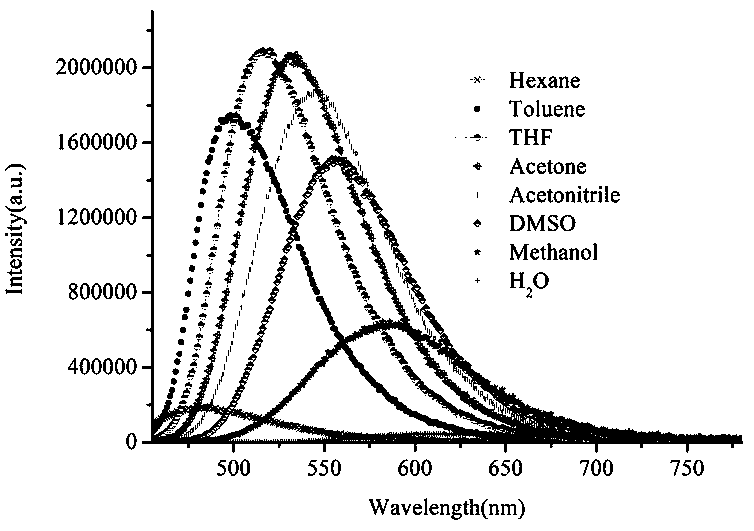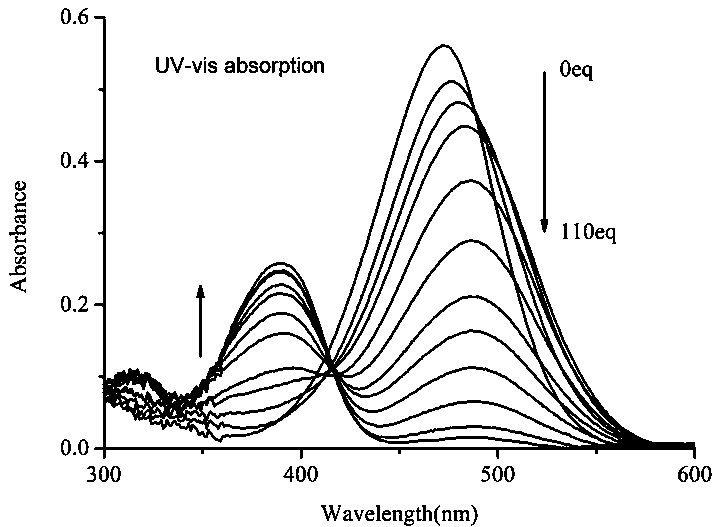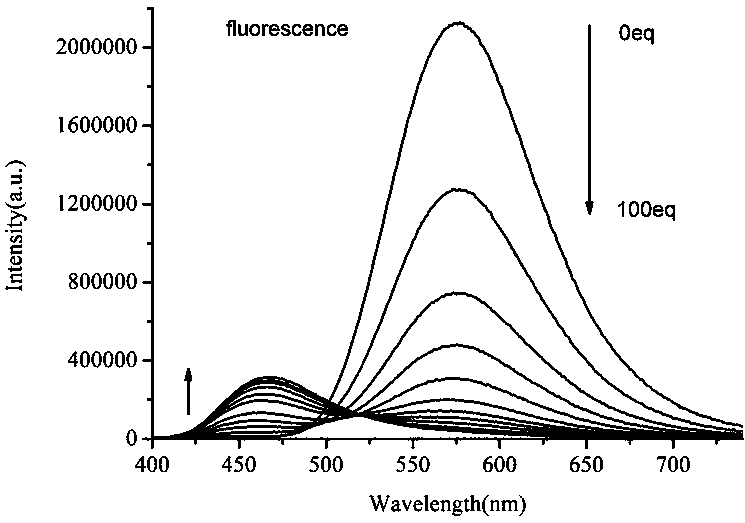Novel hydrazine fluorescence probe for coumarin derivative
A technology of coumarin derivatives and fluorescent probes, which is applied in the direction of fluorescence/phosphorescence, luminescent materials, and material analysis through optical means, can solve the problems of complex synthesis process, low sensitivity, slow response, etc., and achieve operational steps Simple, low environmental requirements, good selective effect
- Summary
- Abstract
- Description
- Claims
- Application Information
AI Technical Summary
Problems solved by technology
Method used
Image
Examples
Embodiment 1
[0025] Preparation of 7-N,N-Diethylamino-coumarin-3-carbaldehyde
[0026] Diethylamino salicylaldehyde (0.965 g, 5 mol), diethyl malonate (1.6 g, 1.53 mL), piperidine (0.5 mL) were added to 15 ml of absolute ethanol and refluxed for 18 h (120°C ), distilled under reduced pressure (oil), 20 ml of concentrated hydrochloric acid and 20 ml of glacial acetic acid were added to the solution, and stirred at 115°C for 19 h. Cool the solution to room temperature, pour it into 100 mL of ice water, then add NaOH dropwise to adjust the pH to 5 (discoloration of the solution) and precipitate immediately, stir for 1 h, filter with suction, wash with water, and dry to obtain a matcha-colored solid. Add 6.5 mL redistilled N,N-dimethylformamide dropwise to 6.5 mL POCl 3 in N 2 Stirred under protective conditions for 30 min, the solution gradually turned yellow. Dissolve the matcha-colored solid in 30 mL of N,N-dimethylformamide, and add it dropwise to the yellow solution to generate a dark ...
Embodiment 2
[0030] Preparation of novel hydrazine fluorescent probes for coumarin derivatives
[0031] (1) Take 0.15 mL of 2-hydroxyacetophenone and 0.245 g of 7-N,N-diethylamino-coumarin-3-carbaldehyde, pour it into a 50 mL flask, add 0.7 mL of pyrrolidine as catalyst, and then added 18 mL of absolute ethanol as a solvent, and stirred at room temperature for 12 h. Filter and wash 3 times with absolute ethanol, and dry to obtain pure intermediate a, which is a red solid.
[0032] The synthetic route is as follows:
[0033] .
[0034] (2) Add 0.0363 g of a and 0.0715 g of levulinic acid into a 100 mL volumetric flask, add 18 mL of anhydrous dichloromethane, and use EDC as a condensation agent and DMAP as a catalyst, add 0.024 g respectively, 0.001 g, reacted at room temperature for 8 h, and then purified it by silica gel chromatography to obtain an orange solid, which was the final product CCL. 1 HNMR (CDCl 3 , 400MHz), δ (ppm): 1.24 (t, J = 7.1Hz, 6H), 2.20 (s, 3H), 2.87 (s,4H), ...
Embodiment 3
[0038] Exploration of solute chromogenic phenomenon of novel hydrazine fluorescent probe
[0039] In n-hexane, toluene, tetrahydrofuran, acetone, acetonitrile, dimethyl sulfoxide, methanol, and water, add the fluorescent probe at an initial concentration of 1 mM, so that the concentration of the fluorescent probe in the solution is 10 μM. Make its fluorescence spectrum change curve in different polar solvents. Such as figure 1 The results show that with the increase of solvent polarity, the fluorescence peak has obvious red shift, showing excellent solute color development.
PUM
 Login to View More
Login to View More Abstract
Description
Claims
Application Information
 Login to View More
Login to View More - R&D
- Intellectual Property
- Life Sciences
- Materials
- Tech Scout
- Unparalleled Data Quality
- Higher Quality Content
- 60% Fewer Hallucinations
Browse by: Latest US Patents, China's latest patents, Technical Efficacy Thesaurus, Application Domain, Technology Topic, Popular Technical Reports.
© 2025 PatSnap. All rights reserved.Legal|Privacy policy|Modern Slavery Act Transparency Statement|Sitemap|About US| Contact US: help@patsnap.com



